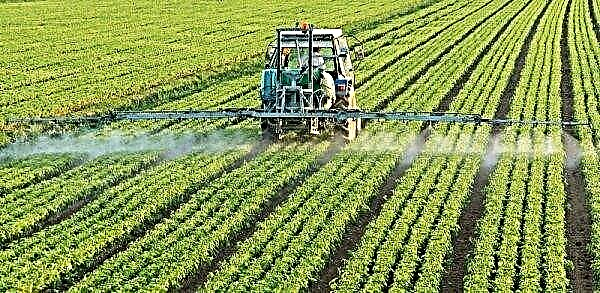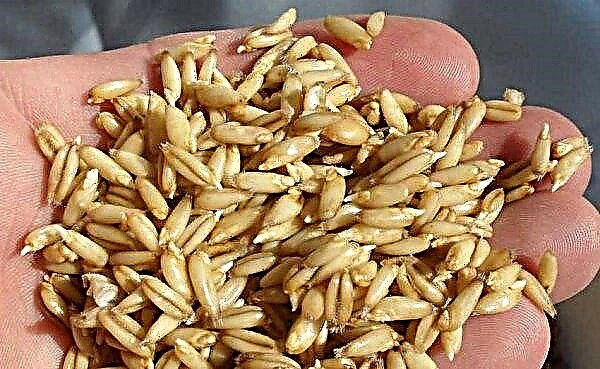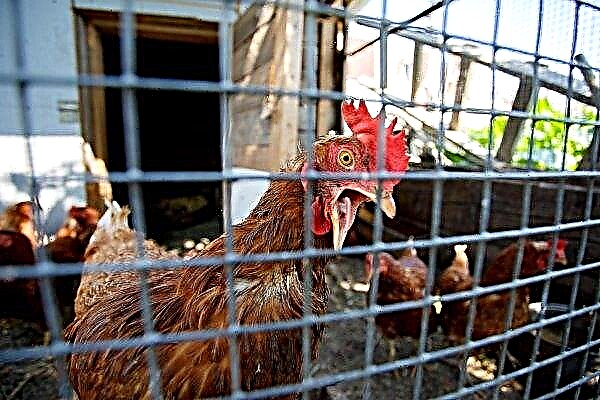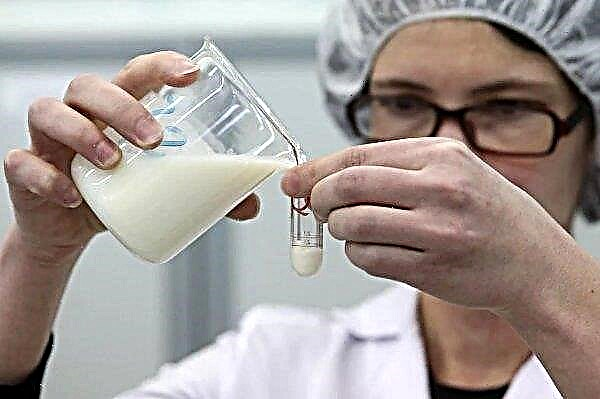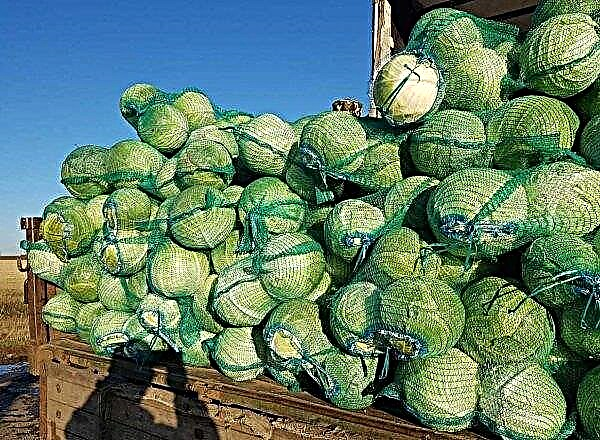The success of the entire vegetable growing industry often depends on the right choice of fruit crop variety. That is why most farmers resort to growing only the most successful and professional hybrids. One of these plants is Amsterdam carrots, characterized by excellent production characteristics. Next, we consider the description of this variety, as well as all its requirements for successful growth and fruiting.
Description and characteristics of the variety
Amsterdam carrots are a high-yielding hybrid of table carrots, designed for private and industrial cultivation. This plant is one of the most found in the temperate zone, where it bears fruit and gives high-quality beam products. The variety is considered quite young - this carrot was zoned only in 1998 for the central climatic regions.
Fruit Description
Ripe carrots are cylindrical with a sharp edge. The average fruit length is in the range of 15–20 cm. The peel of a carrot has a rich orange hue, the cut has a flesh of a dense consistency, rather juicy. The taste characteristics of the crop are high, the fruits have a sweet taste, and also have a delicate carrot flavor.
Ripening time
Amsterdam is an early ripe culture. Subject to the sowing dates, the variety makes it possible to harvest the first crops no later than 90 days after sowing.
Did you know? The largest fruit of carrots was grown by American Christopher Qually in 2017. The young farmer managed to get a fruit weighing about 10 kg, while using exclusively traditional technology for growing vegetables.
Productivity
The average yield of the variety is in the range of 5–7 kg / m². In the case of creating ideal conditions for growing, yield indicators may increase. At the same time, the mass of one average carrot is in the range of 150–170 g.
Pros and cons of the variety
- The main advantages of the variety Amsterdam:
- excellent commercial quality of fruits;
- good taste characteristics of the crop;
- with excess moisture, root crops do not crack;
- increased resistance to flare;
- can be used for winter sowing.
- The plants under consideration also have disadvantages, the main of them are the following:
- lack of resistance to characteristic diseases and pests of culture;
- the plant needs regular watering, otherwise the quality of the crop decreases significantly;
- insufficient crop productivity;
- low yield of crops.
Features of growing carrots Amsterdam
In order to achieve good variety productivity, planting carrots should be approached not only with all care, but also with strict observance of the main subtleties of root crop agricultural technology. It provides for both the selection of optimal sowing dates, and compliance with measures for soil preparation, as well as seed material.
Optimal conditions for sowing
Carrots are not considered a cold-resistant crop, therefore, their cultivation requires a temperature of at least + 5 ° C. However, to achieve the germination of seedlings, seeds are sown only when the soil temperature warms up to at least + 8 ° С.
The culture is quite demanding on the composition of the soil. The highest quality crops are observed on loamy and sandy loamy soils, with a moderate nitrogen content and an increased concentration of phosphorus, calcium and potassium compounds. In addition, sowing should be carried out only after the soil has restored its natural moisture index after snow melts: high moisture levels can cause seed decay.
Sowing dates
Most often, carrots are sown in early spring, immediately after the onset of a full thaw. Depending on the climatic features of the region, seeds are sown from late March to the first half of April. If it is planned to grow a crop in an intensive vegetable growing system that provides for the earliest harvests (2–4 weeks earlier than average varieties), then carrots are sown before winter. The best time for this can be called the second half of November.
Important! With winter sowing, the seeding rate of seeds is increased by 30–40%. This will help to avoid low germination of the crop, and with this reduced productivity of the beds.
Site selection and soil preparation
Carrots need an abundance of light and space, so it is planted only in open and well-lit areas - this is the south or south-west side of the site. A place for sowing should be located at a distance of at least 3-5 m from tall vegetation or garden buildings. Otherwise, shaded plants will form an insufficiently high-quality crop.
When choosing the optimal place for sowing, it is imperative to consider the basics of crop rotation:
- carrots should not be grown in the same place more often than 1 time in 3-4 years;
- parsley, dill, celery and parsnip are considered the worst predecessors of vegetables;
- the highest quality carrot yields are observed after planting cucumbers, tomatoes, potatoes, onions, garlic and cabbage on the spot.
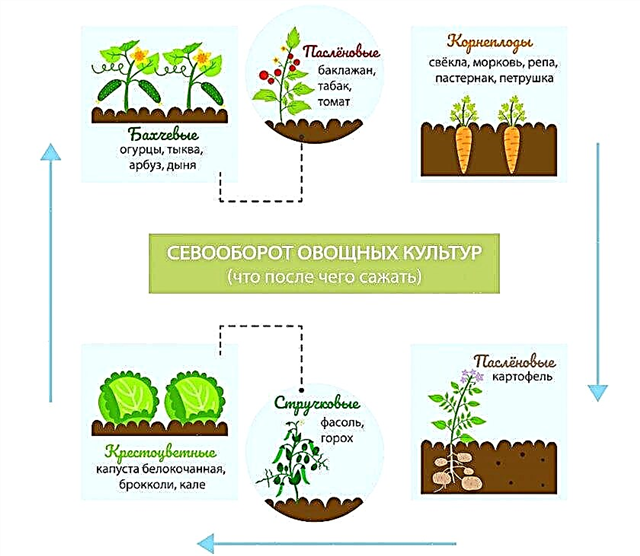
Sowing begins with the preparation of the site - perform the procedure approximately 2 weeks before the expected date of sowing, cleaning the soil from the remains of vegetation and other debris. After this, the substrate is loosened to a depth of at least 20-30 cm. Often this is done twice, which helps give the soil a special airiness. If chernozem or heavy clay soils prevail in the garden, they must be lightened. For this, about 1-3 buckets of sand are applied per 1 m². Sandy soil, on the contrary, is aggravated by adding 1–3 clay buckets per 1 m². Also, if possible, the soil should be fertilized: this makes it possible to increase not only the productivity of plants, but also the marketability of root crops. To fertilize the soil properly, about 5 kg of peat or humus, 300 g of crushed sawdust, and 2 tbsp. l superphosphate, 1 tbsp. potassium sulfate and 1 part sodium nitrate.
Also, if possible, the soil should be fertilized: this makes it possible to increase not only the productivity of plants, but also the marketability of root crops. To fertilize the soil properly, about 5 kg of peat or humus, 300 g of crushed sawdust, and 2 tbsp. l superphosphate, 1 tbsp. potassium sulfate and 1 part sodium nitrate.
Did you know? The original color of the carrot fruit was a variety of shades of purple, yellow, scarlet and black. Orange varieties with sweet pulp were artificially isolated in the 17th century as a result of various experiments by Dutch breeders.
Seed preparation and sowing scheme
Seed preparation is a mandatory measure that is carried out before sowing. It helps improve seed germination, as well as cull poor-quality seeds.
Prepare them like this:
- Seeds are poured with warm water, and then kept at room temperature for 10 hours. Pop-up seed is removed.

- To protect crops from fungi, seeds need to be sterilized. Perform the procedure by soaking the seeds in 70% alcohol (for 10 minutes) or 2% potassium permanganate (about 25-30 minutes). After that, they are thoroughly washed under running water.

- To accelerate the growth of seeds, they need to be activated. For this, the seeds are laid out on a damp cloth or cotton wool, after which they are placed in a well-lit place with a temperature of about +20 ... + 25 ° С for 2-3 days. After the seed gives a small root and sprout, it can be placed in the soil.

Sowing is carried out in an ordinary way: on the ground create furrows parallel to the largest side of the proposed place under the beds. In this case, row spacings should be at least 15 cm, and the distance between adjacent seeds in a row should be 2 cm or more. Carrot seeds are not able to germinate through a dense soil crust, so they are sown to a depth of 2-3 cm.
Agricultural technology
Qualified sowing is not enough to ensure that Amsterdam carrots actively grow and begin to bear fruit. Also on the site, you need to create a specific care system that provides plantings with a special microclimate. To do this, you need to resort to regular watering, top dressing and the fight against possible problems.
Important! When winter sowing, the beds should be mulched with sawdust, pine needles, wood, husk seeds, etc. This will protect the crops from freezing during frosts.
Watering frequency
The abundance of moisture is the main thing that provides carrots with rich and aromatic fruits, so this procedure is considered the most important care measure. A lack of moisture can provoke bitterness and lethargy of root crops, so the beds are watered as often as possible. Do this so that the water completely saturates the topsoil (about 30 cm). Accordingly, during the drought period, the beds are recommended to be watered every 1-2 days, in other periods - at least 2 times a week, with a calculation of 10–20 L of water / m² of plantings.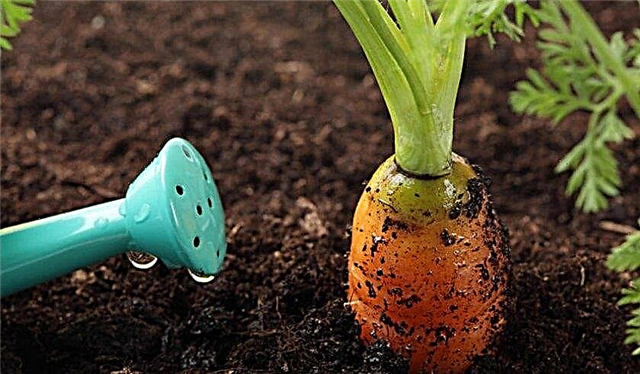
Fertilizers
The culture needs only 2 top dressings per season. The first time the beds are fertilized approximately 3 weeks after the emergence of full seedlings, the second time - after about 7-8 weeks. Fertilizers are applied in liquid form: for this, 2 cups of chopped wood ash are dissolved in 10 liters of water, 1 tbsp. nitrophosphates, 20 g of potassium nitrate and 15 g of superphosphate and urea each. The resulting mixture is used at the rate of 5-10 l / m² of stands.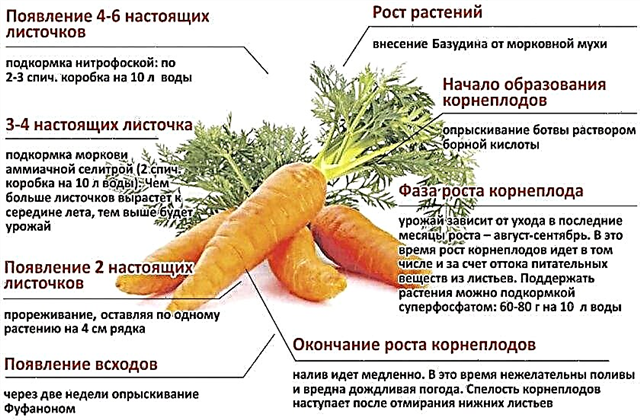
Thinning and weed control
Proper soil care is an integral part of skilled carrot cultivation. Among a variety of crop care measures, weeding is considered the most important., therefore, spend it weekly, about 3-4 hours after watering. During the procedure, the soil is loosened to a depth of about 7 cm, while not only the aboveground and underground parts of the weeds are removed and disposed of.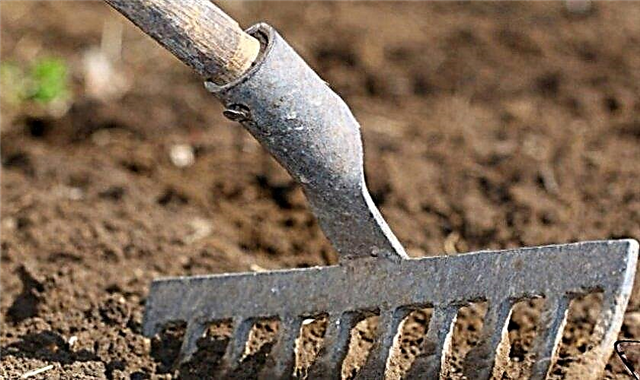
Thinning of crops is also an indispensable procedure.. It protects the beds from the competition of neighboring plants for soil and nutrients, which only positively affects the quality and quantity of fruits. The first time the procedure is carried out when the plants enter the phase of 2-3 leaves: make it so that between 1.5 g of free space between adjacent sprouts, the second thinning is done approximately 3-4 weeks after the first, when the aerial part of the plants lengthens up to 10 cm. At this time, a distance of at least 6–8 cm is created between neighboring plants.
The best time for weeding and thinning is considered early morning. When caring for crops during this period, one can almost completely avoid infection of plantations with a carrot fly, which is often attracted by the smell of damaged carrot tops. In addition, in order to avoid the appearance of an insect, it is imperative that all plant residues be removed and disposed of from the beds.
Pest and Disease Control
Pests and diseases among Amsterdam carrot crops are not uncommon, therefore, every vegetable grower should resort to the prevention of their appearance. The biggest danger is the carrot fly and other sucking parasites. They lead not only to the withering of the tops, but also to the defeat of the plantations by larvae. 
To overcome insects, apply spraying with the preparations "Actellik" and "Intavir" - they are made twice, with an interval of 14 days. For prophylaxis, the procedure is performed once a month, starting from 3 weeks after the emergence of plants. Also a dangerous pest of the culture is considered a slug that feeds on tops. It can be overcome by processing the beds with 10% salt solution.
With the appearance of putrefactive foci and various spots on the green mass and the top of root crops, we can talk about fungal damage to the beds. To combat it, spraying is carried out with a 1% solution of the Bordeaux mixture or with the Fitosporin preparation. This procedure is carried out at least twice, with an interval of 14 days. As a preventive measure, it is performed once every 30 days - only after 3 weeks from the time of emergence of seedlings on the beds.Important! To reduce the number of carrot treatments from pests, anise or mint should be planted around the beds: the sharp and saturated smell of these herbs will create a natural barrier for them.
Features of the collection and preparation of the crop for storage
Carrots are harvested from the beginning to mid-July. At this time, the crop acquires a characteristic color, size and taste. Root crops are harvested in dry and sunny weather.. They are removed from the site manually, but with an excessively dense substrate, you can gently dig beds. Harvested carrots are laid out in a dry shaded place on a litter of burlap or other breathable material. In such conditions, the crop is dried for several hours, after which it is sorted and cleaned from tops.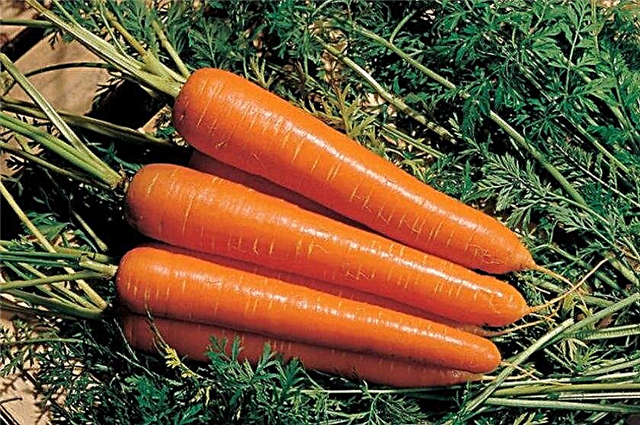
Prepared fruits are stored at temperatures from 0 to + 10 ° C - in the cellar or vegetable store. It is convenient to use boxes made of wood or plastic. Over time, carrots are sorted, but this does not allow the fruits to be stored until the next season. Due to their low storage life, they deteriorate by the end of spring, so before this period they must be used or subjected to conservation.
Amsterdam carrots are a modern hybrid of a fruit plant, which is notable for good productivity. The specified culture is unpretentious, therefore it is able to develop and bear fruit under almost any soil conditions.




